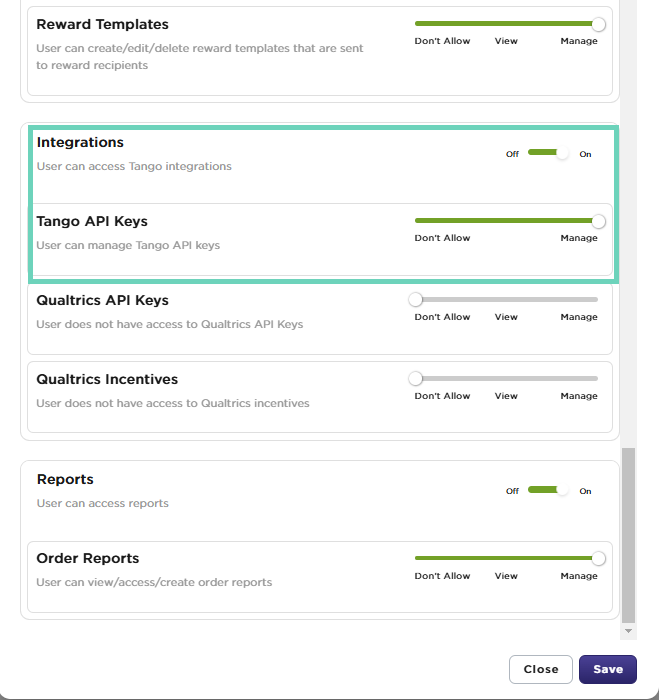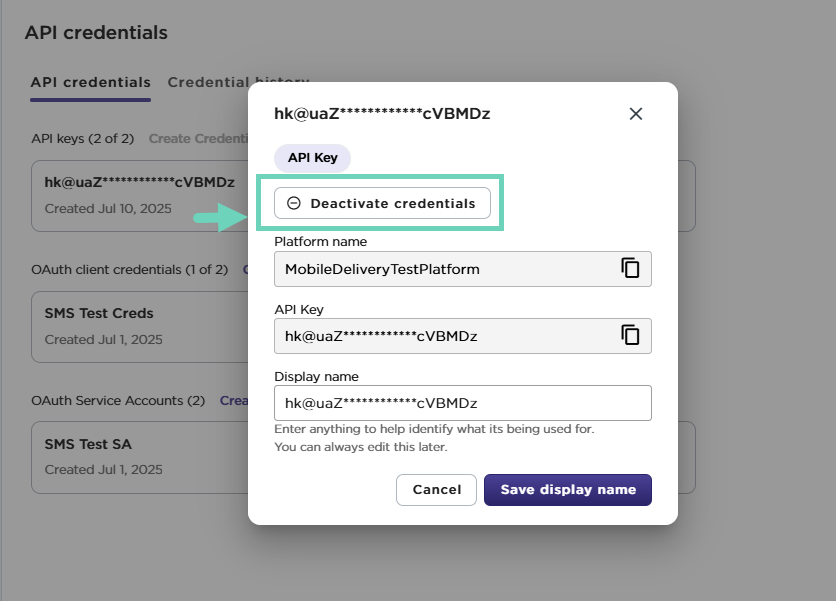To take full advantage of our Tango API resources, you must establish a secure connection with the Tango API. Basic Auth is an authentication protocol that verifies your identity by requesting your username (platform name) and password (API Key). It’s is a simple way to connect the Tango platform with your API.
Tango API keys must be enabled for your Tango platform before utilizing it. Access your Basic Auth’s platform name and API key in the Tango portal under API credentials > API keys. See how to Get started with Tango API. See API guide to learn how to Secure your connection with Basic Auth.
Best Practice:
-
You can have up to two active API keys at any given time. We recommend keeping only one active key if you’re not rotating your keys.
-
Rotate your keys at least every six months AND whenever someone with access to the key leaves the company. To avoid disruption when you rotate the keys, have two active API keys. Once you deactivate your key, you cannot undo it.
To enable Basic Auth (API keys) for your Tango portal for the first time, you must contact your Tango representative. See how to get ready in Get started with Tango API. Contact Customer Success Manager (CSM) or success@tangocard.com for help. If you don’t yet have a Tango portal, Sign up for a Tango platform.
Keep your API keys safe
For your security, Tango API keys are masked in the Tango portal. Treat your API keys like passwords and do not share them with unauthorized parties or over unsecured communication channels.
Required permissions
In order to access API keys, you must have manage permissions for Tango API keys enabled for your user under the Integrations permissions. If you’re not an admin, reach out to your Tango portal admin to give you permission. Learn how to Set user permissions and access level.

View API keys in Tango portal
You can view your API keys in the Tango portal and use it for your API integration. Make sure to use the right production or sandbox environment when connecting to the Tango API. Tango allows API developers to test using a sandbox environment before integrating with Tango production platform. See Set up work environment for Tango API.
To view API keys in Tango portal:
- Sign in to Tango portal.
- Click API credentials.
- Click an existing API keys box to view the following information:
|
Field
|
Description
|
|---|
| Platform name | The name of your platform also used as the username for Basic Auth API connection. Copy  the client ID and paste the value directly, or save it somewhere secure for later use. the client ID and paste the value directly, or save it somewhere secure for later use. |
| API key | The password generated for Basic Auth API connection. Copy  the client ID and paste the value directly, or save it somewhere secure for later use. the client ID and paste the value directly, or save it somewhere secure for later use. |
| Display name | A memorable name to help identify what this key is used for. You can edit this field later. |
-
(Optional) Enter a meaningful name for Display name and click Save display name.
-
To view the history and Tango portal user’s information, go to the API credentials > Credential history tab.
- Select API keys from the drop-down menu. You can narrow down your search. Find the following information:
|
Field
|
Description
|
|---|
| Action | Indicates whether the key has been created or viewed |
| Credential name | Shows the key partially masked |
| Date | Indicates the date and time the API key has been generated |
| User's name | Indicates the Tango portal user’s name who has created or viewed this key |
| User's email | Indicates the Tango portal user’s email address |
| Client ID/API key | Shows the client ID or the API key |
| Credential type | Shows the type of credentials such as API key |
- Click
 to show or hide the table columns.
to show or hide the table columns.
Generate new API keys
New API keys are recommended for your platform when an API key has been compromised, or you no longer use the integration connected to your account. You can have up to two active API keys at the same time. You cannot reactivate a revoked API key, but can generate a new key and update the integrations that used the original key.
To generate a new API key:
- Sign in to Tango portal.
- Click API credentials on the left menu.
- Go to API keys.
- Click Create Credentials on top of the API keys box. You can have up to two active keys at any time. A new key is generated and immediately accessible for use.

- (Optional) Enter a Display name to help identify it later.
- Click Save display name.
The new API key is generated and immediately accessible for use. To discover details regarding creation, update, or views, go to the Credential history page.
Deactivate API keys
You can have up to two active keys at the same time. When you deactivate an API key, your integration is broken. You can deactivate an API key for several reasons:
- A security best practice—to cycle them regularly
- To prevent harm— you think your API has been compromised
- To stay cautious—when people with access leave the company
Note:
Deactivating an API key breaks your integration. If you’re still using that integration, you need to generate a new API key. Deactivation cannot be reversed.
To deactivate an API key:
- Sign in to Tango portal.
- Click API credentials on the left menu.
- Locate the API keys box you would like to deactivate.
- Click Deactivate credentials on the top.

You will receive a warning to make sure to update the credentials in your consuming application before deactivating. Your app will stop working if you deactivate. - Click Deactivate credentials to confirm. A record of the deactivated API key can be seen in the Credential history page.



